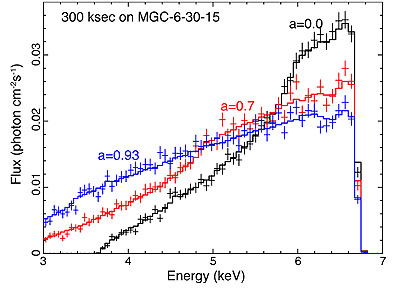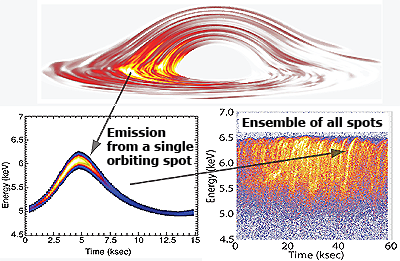 |
Goddard Space
Flight Center NASA > GSFC > Astrophysics Science Division > IXO |
|

You are here: Science» Science Goals» Matter under Extreme Conditions» Matter Orbiting Black Hole» Continued
Matter Orbiting a Black Hole – continuedWhat are the demographics of black hole spin, and what do they tell us about black hole formation and growth? « The measurements of the width of the iron Kα emission line in accreting supermassive black holes will enable a spin census of black holes, providing a key test of black hole and galaxy formation scenarios. IXO will use broad iron line profiles to measure black hole spin in both AGN and Galactic black holes by collecting very high signal-to-noise X-ray spectra (millions of counts from 2-10 keV). X-ray polarization is also sensitive to exotic physical processes occurring in regions of very strong gravity and magnetic fields. General Relativity (GR) predicts that the plane of polarization of photons propagating close to black holes is rotated by an amount that depends on the proximity to the hole and its spin. IXO will be able to measure this X-ray polarization. 
Rotation of the SMBH is expected to produce a "red wing" extending to lower energies in the profile of the Fe Kα. With IXO it will be possible to observe the "red wing" and measure accurately the related amount of black hole spin. Courtesy Laura Brenneman. Click the image for a larger view. 
Polarization observations can accurately determine the spin/mass (a/M) ratio for a typical galactic BH binary. A 100 ksec XPOL observation will make energy-resolved measurements each sensitive to ∼0.5% (3s), easily separating these models. Credit: Schnittman & Krolik (2009). Click the image for a larger view. Observations of SMBHs with XMM-Newton have revealed evidence of "hot spots" on the disk that light up in the iron Kα line, allowing us to infer their motions. Each parcel of gas follows a nearly circular orbit around a black hole. Tracing these on sub-orbital timescales, however, requires the large 0.65 m2 effective area around 6 keV provided by IXO, see Requirements.The emission from these hot spots appears as "arcs" in the time-energy plane. General relativity (GR) makes specific predictions for the form of these arcs, and the ensemble of arcs reveals the mass and spin of the black hole and the inclination of the accretion disk. Deviations from the GR predictions will create apparent changes in these parameters as a function of time or hot spot radius. IXO will enable the first orbital time-resolved studies of 10–20 SMBH and provide a direct probe of the physics of strong gravity. 
IXO will resolve multiple hot spots in energy and time as they orbit the SMBH, each of which traces the Kerr metric at a particular radius. In the time-energy plane, the emission from these hot spots appears as “arcs,” each corresponding to an orbit of a given bright region. Courtesy Armitage & Reynolds (2003). Click the image for a larger view. See IXO Technology: X-ray Polarimeter For more information, refer to IXO Astro 2010 Decadal White Papers: |